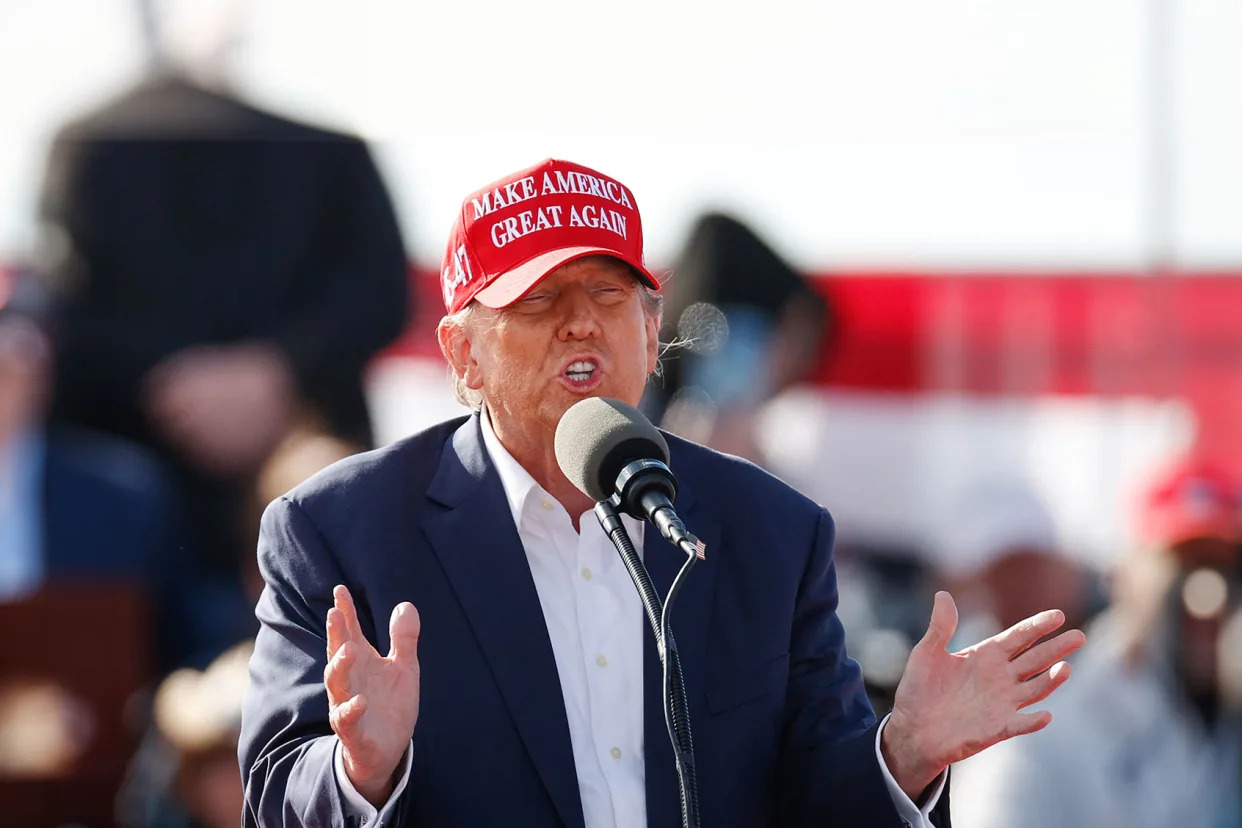CNN
Trump stares down first derailment of his campaign-to-courthouse strategy
Phil Mattingly and Andrew Seger – March 23, 2024

For days, Donald Trump’s fury over the requirement to secure hundreds of millions of dollars in bond money by Monday has been bubbling behind the scenes and through a steady stream of social media posts.
Friday’s public barrage on his Truth Social platform, which included multiple all-caps posts, highlighted his persistent anger with the judge who handed down the $464 million judgment, the New York attorney general who brought the civil fraud case and Trump’s insistence that it’s all designed to derail his presidential campaign.
The posts, including one sent just before 2 a.m. Friday, contained a mix of invective and claims devoid of fact or evidence. (There is no evidence that the White House has played any role in the case brought by New York Attorney General Letitia James, let alone ordered her to pursue her effort. Nor is there any evidence that Trump, as he claimed, has plans to use any of his own money for his presidential campaign.)
But also embedded in the posts was a reality that has pushed Trump’s company and personal finances to the brink with just two days remaining to land a solution.
Trump, as he himself noted, does have a significant amount of cash, according to a review of his most recent candidate financial disclosure and personal financial statements.
It’s a point he made repeatedly in his deposition and testimony during the New York fraud trial though that diverged from his latest social media claim of having “almost five hundred million dollars in cash.” He consistently pegged the number during legal proceedings at $400 million and, barring any recent and unreported cash infusion, a person familiar with his finances confirmed that remains roughly where his cash holdings stand.
Yet even if the higher-end estimate is accurate, as Trump’s lawyers have made clear in sober, detailed filings, it wouldn’t be enough.
The $464 million decision levied in the verdict, and the bond Trump is scrambling to secure to forestall potential seizure of his properties, would require cash or cash equivalent of roughly $557 million based on industry practice.
And at least some of the money Trump does have is tied up in loan agreements that include terms requiring him to have tens of millions of dollars in cash on hand.
In other words, as the clock ticks toward the Monday deadline, securing a bond of the scale required remains – to quote Trump’s own lawyers – a “practical impossibility.”
A deft strategy
Trump’s deft navigation of – and ability to leverage – his unprecedented collision of the campaign and courthouse has defined the path he bulldozed to once again become the Republican Party’s presumptive presidential nominee.
But it was a filing by New York state lawyers at a county clerk’s office 25 miles north of Trump Tower that demonstrated how perilously close the former president is to a dramatic derailment of that strategy.
The move by James’ office to enter judgments in Westchester County marked a first step toward seizing Trump’s assets should he fail to secure a bond.
Westchester County is home to Trump’s golf course and private estate known as Seven Springs.
The initial action, which state lawyers already took in Manhattan, is just the start to what would be a complex and lengthy process.
It also came as Trump’s lawyers have continued to press to reduce or waive the bond requirement, calling it “patently unreasonable, unjust and unconstitutional,” in a Wednesday filing.
But for Trump, a man who has made his brand and his buildings his central animating feature, the filing that put a target on one of his properties crystalized a moment unlike any other he’s faced in his White House comeback bid.
“I think the whole thing is bullsh*t,” one House Republican, who communicates with Trump’s team said of the order to secure the $464 million bond while waiting for a decision on his appeal. “But it had gotten to the point where it seemed like nothing will ever stick to him, so this has been different.”
In other words, there may be actual consequences.
Enduring GOP support
Over nearly a year, as four indictments and 88 charges piled on, Trump’s poll numbers in the GOP primary tracked a steady climb.
Days when Trump faced charges, or showed up at court to face those charges, consistently ranked among his best fundraising days on the campaign.
That money, in part, has covered Trump’s legal bills so he wouldn’t have to on his own.
The lawyers that money financed have been both unequivocal about their pursuit of dilatory strategies – and have repeatedly succeeded in those efforts.
If, as countless former campaign officials say, presidential candidates’ most valuable asset is their time, Trump’s decision to repeatedly attend court hearings when his presence wasn’t required made clear his view of the incentives. So did the voters.
Trump successfully cut down – with relative ease – the best financed and most politically gifted of his primary challengers. He all but locked up the GOP nomination after just two primary contests as the party largely fell in line behind a candidate under whose tenure it lost the House, the Senate and the White House.
Trump was also the same candidate whom some publicly – and many more privately – had hoped would simply disappear after the January 6, 2021, attack on the US Capitol and the steady stream of revelations that he and his advisers had sought to overturn Joe Biden’s 2020 victory.
People around Trump say they’ve seen no sign of any political damage from his latest legal stress test. National polls continue to show a margin-of-error contest with Biden, and more importantly, surveys in the critical swing states haven’t revealed a tangible shift. New CNN polling conducted by SSRS in two battleground states showed Trump tied with Biden in Pennsylvania at 46% each, and ahead in Michigan, 50% to 42%.
Biden flipped both states from Trump’s column in 2020.
Trump’s campaign apparatus trails Biden’s team significantly in fundraising, but those around Trump are confident that the gap will be closed. The former president, these people say, has been privately working the party’s biggest donors in a way they haven’t seen before.
“The money will be there,” one person told CNN. “He’s never been more focused or effective on that front than he is right now.”
One adviser mused that any pursuit of Trump’s properties would only serve to help the campaign politically, pointing to email and text donation appeals with lines like “Keep your filthy hands off Trump Tower!” as evidence to that effect.
A cash dilemma
Still, the threat Trump currently faces cuts equally to his political and personal core. It’s also one that carries a level of irony.
In a career, and now verdict, beset by a steady stream of questions about his net worth and the value of his substantial real estate assets, Trump does have a significant amount of cash – and a valuable portfolio of properties, which could more than cover the bond amount.
But insurers rarely take real estate as collateral, fearing a complex process and skewed market where any bids on that property would come from entities well aware of the need to sell, Trump’s lawyers said.
One insurer, Chubb, underwrote a $91.63 million bond just two weeks ago in another Trump legal loss – E. Jean Carroll’s defamation case.
Trump’s team had been in discussions with Chubb over a second bond for the fraud case that included a mix of liquid assets and property. In the past week, the insurer informed Trump’s team it could not accept property as collateral.
In total, 30 insurers contacted by Trump’s team declined to pursue the effort to secure a bond. Trump, in a Truth Social posting, alluded to that fact when he noted that it “is not possible for bonding companies to do in such a high amount, before I can even Appeal. That is CRAZY! If I sold assets, and then won the Appeal, the assets would be forever gone.”
There has been a steady stream of rumors about some of Trump’s richest backers stepping in to put up the cash.
But so far there has been no confirmation of concrete requests, let alone movement toward any agreement.
Another potential pathway that Trump allies have discussed opened up Friday when investors approved a merger that made the former president’s media enterprise, Trump Media and Technology Group, a public company. Trump’s holdings in the new company would, on their face, net him billions in stock.
But the availability of that cash from the parent company of Truth Social would be subject to a six month “lockup” period that would hamstring Trump’s ability to sell any shares or use them as collateral. The billions Trump stands to gain exist only on paper – and would be subject to the price fluctuations of the stock when it starts to trade.
Any effort by Trump to get around that lockup period in order to monetize his shares would likely have a direct, and negative, effect on the stock’s price.
Watching his image
Trump has repeatedly dismissed the idea of pursuing bankruptcy, which would freeze the proceedings for what would likely be an extended period of time.
The reasons, advisers say, cut across personal and political concerns.
Trump has been publicly vocal about the deep scars he carries from bankruptcies decades ago.
“It was an experience that I don’t think I want to go through it again,” Trump said in a 1992 interview with Charlie Rose. “You’re really in a position where I think that if you had to do it again, I’m not sure you could. I went through a period of two years that was truly tough.”
Trump is also cognizant of the potential threat it could pose to his carefully crafted image that sits at the heart of his political salience: that of a billionaire business tycoon.
“No chance,” one adviser said of Trump pursuing bankruptcy. “He’d rather have Letitia James show up and try and seize his properties.”
Whether that version of the campaign and courthouse convergence plays out will be made clear in the days ahead.
For now, however, it has become clear as the deadline to secure the bond looms ever closer, that the playbook that has driven Trump’s political comeback has run into hurdles in the form of hundreds of millions of dollars.
That’s a problem the only political opponent who has ever defeated Trump is happy to highlight.
“I know not everyone is feeling the enthusiasm,” Biden joked at a Dallas fundraising reception this week. “Just the other day a defeated-looking man came up to me and said, ‘Mr. President, I have crushing debt, and I’m completely wiped out.’ And I had to look at him and say, ‘Donald, I’m sorry. I can’t help you.’”













